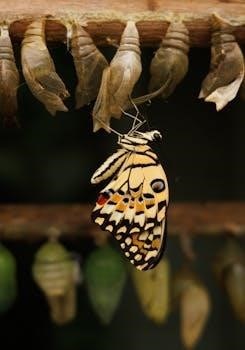caterpillar to butterfly kit instructions
Initial Setup and Caterpillar Care
Upon receiving your kit, carefully check the cup’s lid for 1-2 tiny airflow holes. Place the cup in a quiet, undisturbed location and keep it upright. Observe the caterpillars as they eat and grow for about 7 to 10 days, consuming the provided food.
Checking the Cup and Airflow
Before you even think about your caterpillars, the very first step involves carefully examining the plastic cup they arrived in. This is crucial for their well-being. Specifically, you must check the lid to ensure it has one or two tiny holes. These holes are vital for proper airflow, allowing the caterpillars to breathe and preventing the build-up of excess moisture inside the cup. Without adequate ventilation, the environment within the cup could become unsuitable for the caterpillars, potentially leading to health issues or even fatalities. So, take a moment to confirm that these small but important air holes are present and not blocked by anything. This simple check will ensure your little caterpillars start their journey in the best possible environment. Remember, proper airflow is a key element in their successful transformation.
Placing the Cup in a Safe Location
Once you’ve confirmed the presence of those crucial air holes, the next step is all about finding the perfect spot for your caterpillar cup. This location should be a quiet place, where the cup is unlikely to be disturbed. Avoid areas with high foot traffic, loud noises, or direct sunlight. Direct sunlight can overheat the cup and harm the caterpillars, while constant movement and noise can stress them. A stable shelf, a desk corner, or a countertop away from the edge are good options. It’s also important to ensure that the cup remains in an upright position. Tipping the cup can disrupt the caterpillars and the food supply, so choose a level surface that will prevent accidental spills. Remember, a safe and undisturbed location is essential for your caterpillars to thrive and grow comfortably.
Observing Caterpillar Growth
Now that your caterpillars are settled in their safe location, it’s time to observe their growth and development closely over the next 7 to 10 days. You’ll notice that they are actively eating the food provided in the cup, and they will get bigger each day. Watch as they move around, explore their environment, and shed their skin, a process called molting. This is a normal part of their growth, and you may see the discarded skin within the cup. Pay attention to any changes in their behavior or appearance. Note the size of the caterpillars each day. You should also note any color changes. As they grow, they will eventually reach their full size and begin to prepare for the next stage of their life cycle. This is a great time to appreciate the wonders of nature and the amazing transformation these little creatures undergo.
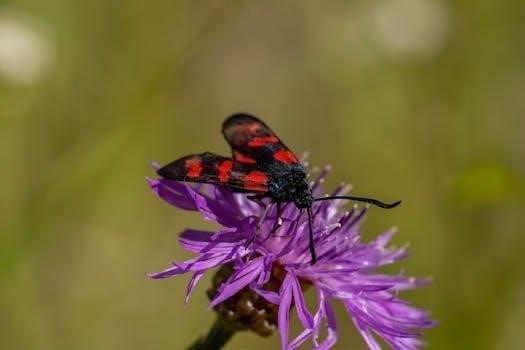
Preparing for Pupation
Before the caterpillars transform into chrysalides, place the cup in the refrigerator for 20-30 minutes. This will slow them down, making the next steps easier and less stressful for them.
Cooling Caterpillars Before Transfer
Prior to moving your caterpillars, it is crucial to gently cool them. This process is designed to slow down their movement, making them easier to handle during the transfer to their new habitat. Place the entire caterpillar cup, as is, into a refrigerator, not a freezer. The ideal duration for this cooling period is between 20 and 30 minutes. This short refrigeration period will not harm the caterpillars but will significantly reduce their activity, thereby minimizing the risk of accidental injury or stress during the subsequent handling. This step is very important to the whole process, because it allows for a smoother and safer transition for your caterpillars as they prepare for pupation. Remember, a gentle approach is crucial at all times during this process.
Waiting Period After Chrysalis Formation
After all your caterpillars have transformed into chrysalides, it’s crucial to exercise patience and allow a specific waiting period before proceeding with the next step. Specifically, you must wait for a minimum of three full days after the last caterpillar has formed its chrysalis. This waiting time is essential because it gives the chrysalides ample opportunity to harden and properly develop, ensuring a smooth and safe transfer to their new habitat. Disturbing them before this period could potentially cause damage or disrupt their delicate pupation process. This phase is a critical part of the butterfly lifecycle, so it’s important to observe but not interfere until the three-day waiting period is over. Remember to handle the chrysalides very gently.
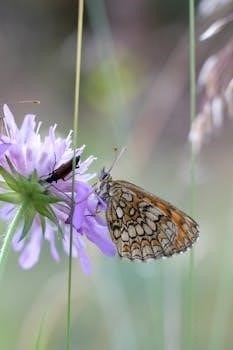
Chrysalis Handling and Habitat Transfer
Gently remove any silk and frass from the chrysalides. Carefully transfer them to the habitat. Ensure a secure placement to avoid damage during the process of their transformation.
Removing Silk and Frass from Chrysalides
Before moving the chrysalides into their new habitat, it’s essential to carefully remove any silk or frass that may be clinging to them. This debris, left over from the pupation process, can hinder the butterflies when they emerge. Gently use a soft brush or your fingers to clear away the silk threads and frass pellets. Take extra care not to apply any pressure to the chrysalis itself; they are very delicate. Removing these materials ensures a clean environment for the butterfly’s transformation. This step, though seemingly small, will significantly improve the butterfly’s chances of a healthy and successful emergence. By taking the time to remove the debris, you are providing an optimal environment for the final stage of development.
Transferring Chrysalides to the Habitat
Once you have removed the silk and frass, it’s time to transfer the chrysalides to their new home, the butterfly habitat. Carefully pick up each chrysalis, being mindful not to squeeze or damage it. Place them gently inside the habitat, ensuring they are hanging in a safe position. You can use the provided hooks or attach them to the mesh sides, but avoid placing them on the floor of the habitat. Give each chrysalis enough space to transform without touching others. The habitat will now serve as a safe haven for the butterflies to complete their metamorphosis. Be sure not to disturb the chrysalides after transfer and allow them to complete the last stage of their development.
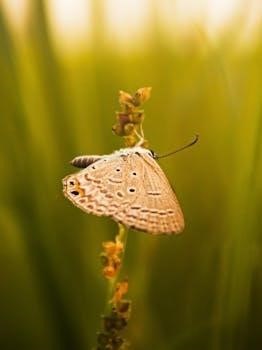
Butterfly Emergence and Care
After the butterflies emerge, set up the feeder with sugar water. Maintain the habitat by cleaning and refilling the feeder regularly. Provide a safe environment for the new butterflies.
Setting up the Butterfly Feeder
Once your butterflies have emerged from their chrysalides, it’s time to prepare their feeding station. The butterfly feeder included in your kit is designed to provide easy access to nourishment for your newly emerged butterflies. Begin by carefully filling the feeder cup almost to the top, ensuring that you leave a small space to prevent spillage. The feeder has a cotton wick that will stay moist and allow the butterflies to easily drink the sugar water. Securely replace the lid of the feeder after filling it. Now, place the assembled feeder on the floor of the habitat, positioning it in a way that is easily accessible for the butterflies. It is important to keep extra sugar water refrigerated between feeding sessions to maintain its freshness. This simple yet crucial setup will help your butterflies thrive in their new environment. Make sure to monitor the feeder and refill as necessary.
Preparing Sugar Water for Butterflies
To provide your butterflies with the necessary energy and hydration, you’ll need to prepare a sugar water solution. This simple mixture will act as their primary food source within the habitat; The ideal solution is made by mixing sugar with warm water, ensuring the sugar is fully dissolved. Start with a ratio of approximately four parts water to one part sugar. Stir the mixture thoroughly until the sugar crystals are no longer visible. This ensures a consistent and palatable food source for your butterflies. Once the solution is ready, allow it to cool before pouring it into the butterfly feeder. It’s crucial to use clean utensils and containers during the preparation process to prevent contamination. Remember to rinse and refill the feeder regularly, without using soap, to maintain a healthy feeding environment. Store any extra sugar water in the refrigerator, using a clean, sealed container to keep it fresh for subsequent use.
Habitat Maintenance and Feeding
Maintaining a clean and suitable habitat is crucial for the health and well-being of your butterflies. Regularly check the habitat for any signs of debris or waste, gently removing them as needed to prevent any potential build-up that could lead to issues. Ensure the butterfly feeder is consistently filled with fresh sugar water, replacing it when it becomes cloudy or depleted. Remember to rinse the feeder with water, avoiding the use of soap, which can be harmful to the butterflies. Keep a close eye on the humidity level within the habitat, as butterflies prefer a slightly moist environment. You can gently mist the habitat with water if it appears too dry. The general rule of thumb is to change the sugar water daily. Make sure the habitat is placed in a location away from direct sunlight and extreme temperatures. Proper care will contribute to the overall health of your butterflies.
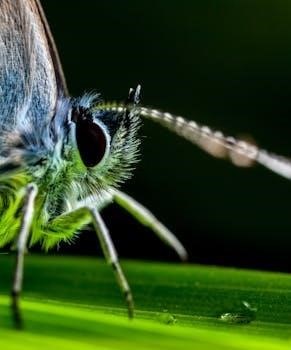
General Information
The butterfly kit includes live Painted Lady caterpillars, a cup with food, and a habitat. The provided food within the cup is sufficient for the caterpillars until they pupate, usually within about 7-10 days.
Contents of the Butterfly Kit
Your butterfly kit typically arrives with several key components designed to facilitate the complete life cycle of painted lady butterflies. Inside, you will find a clear plastic cup containing the live caterpillars. These caterpillars are usually quite small when you first receive them. The cup also contains a specially formulated food source that will sustain the caterpillars throughout their growth phase. This food is pre-measured and sufficient to last until the caterpillars are ready to pupate. Additionally, the kit includes a habitat, often a mesh enclosure, where the butterflies will live after emerging from their chrysalides. The kit may also contain a butterfly feeder, and instructions detailing how to set everything up. A cotton wick for the feeder is also included.
Caterpillar Food Supply
The caterpillar food supply included in your butterfly kit is specially formulated to meet the nutritional needs of painted lady caterpillars. The caterpillars will eat this food throughout their growth phase. This pre-made food ensures that the caterpillars receive all of the necessary nutrients to develop into healthy, robust chrysalides. The food is a soft, gel-like substance that the caterpillars can easily consume. You will notice the caterpillars growing rapidly as they eat and molt. It is not necessary to add any additional food. The provided amount is carefully measured to last until the caterpillars are ready to pupate, so make sure not to disturb the cup during this period. The food is designed to be a complete diet, so there is no need for other supplements.

